 Seventy years ago, America’s youth knew how to make a party click, thanks to the spin of a record, the cut of a caper, and, of course, a bottle of Coke.
Seventy years ago, America’s youth knew how to make a party click, thanks to the spin of a record, the cut of a caper, and, of course, a bottle of Coke.
This ad appeared in the September 1953 issue of Boys’ Life.

 Seventy years ago, America’s youth knew how to make a party click, thanks to the spin of a record, the cut of a caper, and, of course, a bottle of Coke.
Seventy years ago, America’s youth knew how to make a party click, thanks to the spin of a record, the cut of a caper, and, of course, a bottle of Coke.
This ad appeared in the September 1953 issue of Boys’ Life.
 Seventy years ago, this young man is enlivening the family picnic by trying his voice on the mike of this project from the July 1953 issue of Popular Mechanics. The project is billed as a “just for fun” audio amplifier, but it’s actually quite a bit more. In addition to the two-tube battery operated audio amplifier, the project contains provisions for a crystal microphone and phonograph input from a spring-wound record player. It’s not an early prototype karaoke machine, because you can use only one at a time. But the magazine notes that it’s a lot of fun in a group for everyone to try their voice on the mike. It notes that almost everyone talks too fast, some get mike fright, and others use an unnaturally high pitch. It noted that placing the mike was an art, and the set provides a good opportunity to learn a lot about PA systems.
Seventy years ago, this young man is enlivening the family picnic by trying his voice on the mike of this project from the July 1953 issue of Popular Mechanics. The project is billed as a “just for fun” audio amplifier, but it’s actually quite a bit more. In addition to the two-tube battery operated audio amplifier, the project contains provisions for a crystal microphone and phonograph input from a spring-wound record player. It’s not an early prototype karaoke machine, because you can use only one at a time. But the magazine notes that it’s a lot of fun in a group for everyone to try their voice on the mike. It notes that almost everyone talks too fast, some get mike fright, and others use an unnaturally high pitch. It noted that placing the mike was an art, and the set provides a good opportunity to learn a lot about PA systems.
And in addition, the circuit included a built-in germanium diode crystal set which would pull in clear signals from local stations.
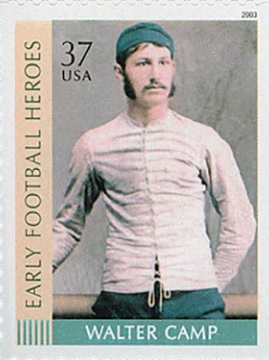 Disclaimer: Don’t get fitness advice from random bloggers, talk to your doctor before starting any exercise program, and please don’t sue us if you get hurt exercising.
Disclaimer: Don’t get fitness advice from random bloggers, talk to your doctor before starting any exercise program, and please don’t sue us if you get hurt exercising.
We previously wrote about Walter Camp’s Daily Dozen, an exercise regimen devised and promoted by Walter Camp, American football player and coach. When the U.S. Army discovered that many conscripts in World War I were badly out of shape, it turned to Camp to come up with an exercise program for sedentary city boys. He came up with the “Daily Dozen,” a series of twelve simple exercises that could be performed in about twenty minutes. Camp also recommended an hour of outdoor play, but the Daily Dozen were seen as a method of getting ready for the day. Camp had observed zoo animals who, like office workers, were unnaturally confined, and his exercises mimicked some of the stretches he had seen these animals instinctively perform.
I recently suffered a broken arm, and as a result, was sent to physical therapy to get the function back. They gave me exercises to do, and as an old out-of-shape sedentary person, I did get in the habit of exercising. When my physical therapy ended, I decided that I ought to take some small step to remain active. And since I had written about an exercise program, I figured that one was as good as any.
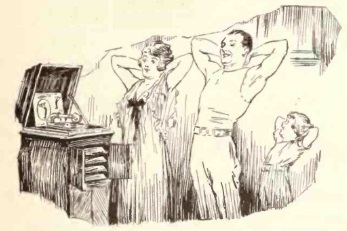 As we previously wrote, Camp produced a set of records with his exercises. While a band plays, Camp barks out his instructions, and you exercise along with the record player. Undoubtedly, Camp was standing next to the band as it played, shouting his commands into the cone of the recording equipment. So a few months ago, I decided to start doing the Daily Dozen. Human physiology hasn’t changed much in the last hundred years, and if Camp could make people more fit in 1922, there’s no reason why he can’t do the same thing today.
As we previously wrote, Camp produced a set of records with his exercises. While a band plays, Camp barks out his instructions, and you exercise along with the record player. Undoubtedly, Camp was standing next to the band as it played, shouting his commands into the cone of the recording equipment. So a few months ago, I decided to start doing the Daily Dozen. Human physiology hasn’t changed much in the last hundred years, and if Camp could make people more fit in 1922, there’s no reason why he can’t do the same thing today.
Even though the exercises are very simple, the 20 minute routine does seem to have a positive effect on my health. For one thing, it has gotten easier after a few months. At first, it wasn’t exactly hard, but it did seem like drudgery. But as time goes by, the routine goes quickly, and quite easy. I do feel more energetic after doing it. And more importantly, I’ve noticed that if I miss doing it for one day, I don’t really feel as well the next day. So it doesn’t do any harm, and it’s probably a benefit. I also try to take Camp’s advice and do some outdoor recreation every day.
If you want to give it a try, Camp’s 1922 record set is available on YouTube:
If you want to see the exercises being done, you can see them in this video. You can find a modern-day discussion and critique in this book at Amazon. You can also find Camp’s own book at this link at Google Books. You’ll notice that the exercises in the videos and books are somewhat different, as the plan changed a bit over the years. I’ve been following the plan from the 1922 record set.
If you’re looking for a modest exercise program to start getting yourself back into some semblance of physical fitness, then you can’t really go wrong with the Daily Dozen.
Some links on this site are affiliate links, meaning that this site earns a small commission if you make a purchase after using the link.
 Seventy years ago, this high fidelity salesperson didn’t need to work hard to make a sale. The equipment practically sold itself, thanks to the “Audiomat” from Asco Sound Corporation. It would accommodate up to ten tuners, twenty amplifiers, and twenty speakers, all of which could be compactly mounted. Then, at a touch of the button, the salesperson would seamlessly switch from one to the other.
Seventy years ago, this high fidelity salesperson didn’t need to work hard to make a sale. The equipment practically sold itself, thanks to the “Audiomat” from Asco Sound Corporation. It would accommodate up to ten tuners, twenty amplifiers, and twenty speakers, all of which could be compactly mounted. Then, at a touch of the button, the salesperson would seamlessly switch from one to the other.
To allow the customer to hear how the equipment would sound at home, the store would have a separate den-sized listening room, with a smaller version of the Audiomat. From there, the customer could make the final decision of what equipment would best suit their needs.
The picture and accompanying article are from the May 1953 issue of Radio News.
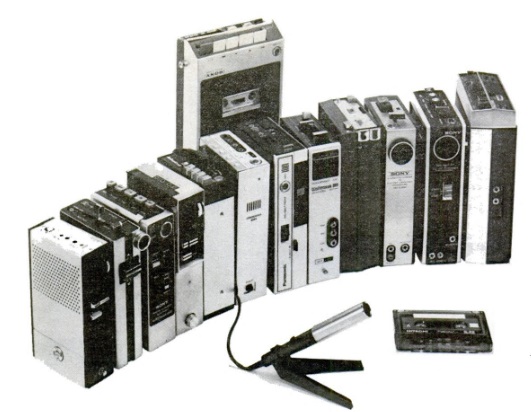 Fifty years ago this month, the April 1973 issue of Popular Mechanics highlighted the many miniature cassette recorders then on the market. Like their slightly older brethren like the one at the rear, all of these played standard sized cassettes. Even smaller models were available using smaller tapes, but the magazine noted that those were often hard to find, so it featured only the models using full sized cassettes.
Fifty years ago this month, the April 1973 issue of Popular Mechanics highlighted the many miniature cassette recorders then on the market. Like their slightly older brethren like the one at the rear, all of these played standard sized cassettes. Even smaller models were available using smaller tapes, but the magazine noted that those were often hard to find, so it featured only the models using full sized cassettes.
Weight of all of these recorders were between one and two pounds. The playback sound was said to be limited, mostly because of the small speaker and underpowered amplifier. But the magazine noted that a recording made on one of the small units, when played back on the good player at home, sounded surprisingly good.
Prices of the sets shown started at about $65.
 This couple are getting ready to enjoy listening to a record on the Philco model 1401 radio-phonograph, which, according to the ad, played records by magic. You didn’t need to lift the lid, nor even look at the tone arm. You just inserted the record into the front, and it played automatically.
This couple are getting ready to enjoy listening to a record on the Philco model 1401 radio-phonograph, which, according to the ad, played records by magic. You didn’t need to lift the lid, nor even look at the tone arm. You just inserted the record into the front, and it played automatically.
This ad appeared in Life magazine 75 years ago today, April 12, 1948. You can see a nicely restored specimen at this video:
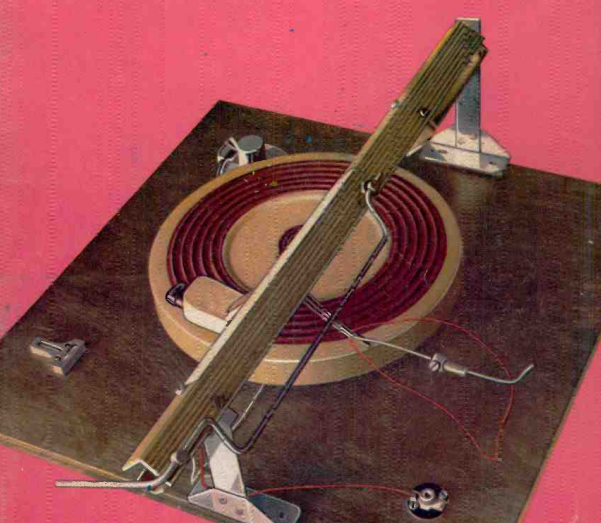 Shown here is a design that never really caught on, although it appears that there are a few purists who still cling to it. This is the parallel tracking turntable, also known as linear tracking. The advantage is said to be less wear and tear on your records, since the outer half of the groove doesn’t need to do the extra work of pushing the tone arm.
Shown here is a design that never really caught on, although it appears that there are a few purists who still cling to it. This is the parallel tracking turntable, also known as linear tracking. The advantage is said to be less wear and tear on your records, since the outer half of the groove doesn’t need to do the extra work of pushing the tone arm.
This illustration appeared on the cover of the British Popular Wireless, March 1963, and the accompanying article showed how to build it. If you don’t want to go to that trouble, and you’re an audiophile purist, you can purchase this one. One thing we can say for sure is that the advantage of such a turntable is even greater than oxygen-free speaker wire.
 If you were in the market for a radio or phonograph 60 years ago, you could pick up one of these at the local drug store, although the ad admonished you not to call it that.
If you were in the market for a radio or phonograph 60 years ago, you could pick up one of these at the local drug store, although the ad admonished you not to call it that.
Shown here are the GE Model 1530 stereo phonograph, and models C465 and C467, and models C433 and C434 clock radios. The radios are typical “All American Five” circuits. Come to think of it, my first ever radio of my very own was a similar model (but without the clock) also purchased from a local drug store.
The ad appeared in the Washington Evening Star, February 27, 1963.
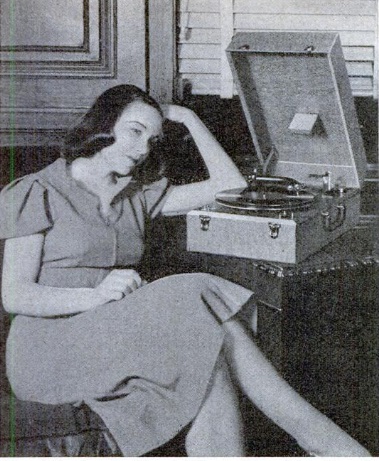 If you were in the market for a portable source of music 85 years ago, you couldn’t go wrong with this portable electric phonograph, shown in the February 1938 issue of Popular Science.
If you were in the market for a portable source of music 85 years ago, you couldn’t go wrong with this portable electric phonograph, shown in the February 1938 issue of Popular Science.
It weighed in at only 18 pounds, and measured a mere 7.5 x 11 x 18 inches. It featured a crystal pickup and six-inch speaker driven by a three-tube amplifier, and it could play either 10 or 12 inch records.
The magazine didn’t mention the name of the manufacturer, and the price is likewise not given. There was a Depression going on, and coming up with the purchase price might have been an issue for some readers. But the same issue of the magazine solved that problem, thanks to the ad below. You could assemble kayaks (dubbed Ki-Yak by the manufacturer, Mead Gliders, 15 S. Market St., Chicago)
The price is not shown here, but the kit apparently retailed for $15.75. One could assemble it at home in a few nights, and undoubtedly sell it for a tidy profit.
If you’re in the market for a similar phonograph today, they are indeed available, and the modern ones aren’t limited to 78 RPM. And if you want a kayak, they’re relatively inexpensive as well, all put together. As with everything, you can get them on Amazon:
Some links are affiliate links, meaning this site earns a small commission if you make a purchase after following the link.
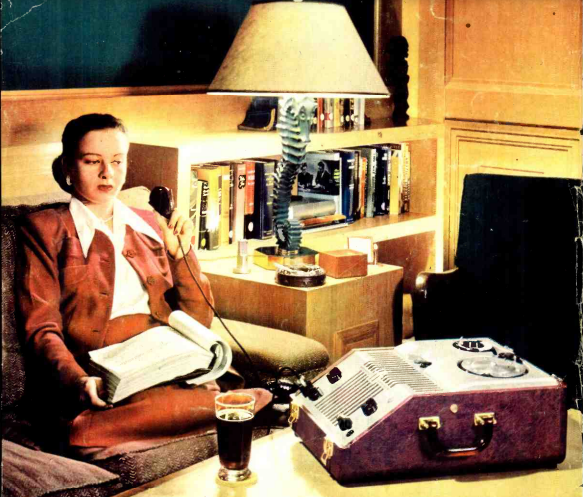 The drama student shown above appeared on the cover of the February 1948 issue of Radio News. The young thespian was an early adopter of magnetic recording technology, one of the many civilian technological advances that came from wartime industry. She used a wire recorder from Webster-Chicago Corp. to practice her diction and delivery.
The drama student shown above appeared on the cover of the February 1948 issue of Radio News. The young thespian was an early adopter of magnetic recording technology, one of the many civilian technological advances that came from wartime industry. She used a wire recorder from Webster-Chicago Corp. to practice her diction and delivery.
Of course, home sound recording had been possible for some time, thanks to disc records such as the Recordio. But magnetic recording media had the great advantage of being reusable.
The magazine contained a number of features, and it does contain a very complete look at the state of the art in 1948. The two competing formats were wire and tape. Wire held a slight lead in fidelity, but tape was easier to work with, especially when it came to editing and splicing. Interestingly, the magnetic recording tape of the time was actually paper tape with a thin magnetic coating. Typical speed was 8 inches per second.
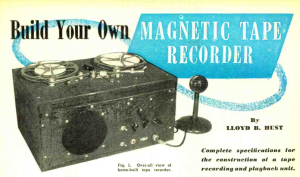 Among the features of the issue was a construction article for the tape recorder shown here. The project was said to be “well within the capabilities of anyone who has a working knowledge of electronic circuits and who has ordinary mechanical ability.” The mechanical ability was important, because all of the parts had to be made. A metalworking lathe was required, although the article noted that those without one could have the parts custom made at a local shop at low cost. As one of the mechanical diagrams shown at right shows, the construction did require some mechanical skill. Apparently, 75 years ago, that level of skill was ordinary.
Among the features of the issue was a construction article for the tape recorder shown here. The project was said to be “well within the capabilities of anyone who has a working knowledge of electronic circuits and who has ordinary mechanical ability.” The mechanical ability was important, because all of the parts had to be made. A metalworking lathe was required, although the article noted that those without one could have the parts custom made at a local shop at low cost. As one of the mechanical diagrams shown at right shows, the construction did require some mechanical skill. Apparently, 75 years ago, that level of skill was ordinary.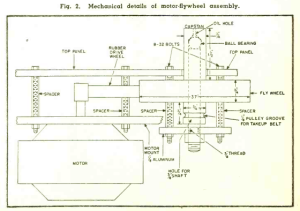
The recording/playback and erase heads also had to be homemade, and consisted of a coil wound on a laminated core and placed in a shielded enclosure with just a small opening for the tape. The choice of material for the core was critical, and had to be permalloy. The type of material normally used for transformer cores would not work. The best solution was to buy a particular type of audio transformer, disassemble it, and use the lamination material for winding the heads.